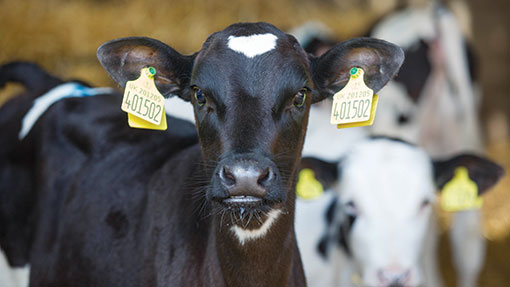Efficient dairy bull beef production can save £185 a head

Achieving a better consistency from day one is the key to black and white dairy bull success.
Rearing dairy bulls is costing some farmers more than a third more money to reach the 230kg target carcass weight, as some animals are taking more than three months longer to get there.
The Buitelaar Group process more than 550 dairy bulls a week from 160 farmers, but when managing director Adam Buitelaar looked at the kill sheets, he saw big differences in efficiency.
“Some reach it [target weight] in 10-and-a-half months, others take 14 months. That’s 35% more cost for the same result,” said Mr Buitelaar.
See also: Dairy bulls achieve amazing gains
“Ten pence a kg difference on a 240kg carcass would be £24, but fattening a bull 3.5 months faster can save £185,” he added.
This highlights that cutting the time to reach target weight can have a more significant effect on margins than getting an extra 10p/kg.
This prompted Mr Buitelaar to call for a systematic approach to calf rearing and maximising output for minimum input at a recent dedicated conference near Stafford. He said he was determined to help beef farmers after seeing a farming culture “sick and tired of price volatility” emerge.
However, farmers were warned that focusing on efficiencies was not the only way to ensure good prices.
Making these efficiency savings could be futile if the animals are overly stressed as they are unloaded at the slaughterhouse, said Kim Matthews, head of Eblex research and development, who pointed out farmers could lose up to £115 an animal for dark, firm and dry (DFD) meat.
“DFD carcasses are downgraded and sometimes totally rejected. Animals that are dark cutting have a lower value as dark meat can’t be matured as well as it spoils,” he said.
“This lower value impacts on the processor’s margin, so it is built into the price paid across the board,” he said.
Research has proved that restless and nervous animals on unloading produce tougher meat, and bulls are especially prone to it, in as many as 10% of young bull carcasses, said Mr Matthews.
DFD meat is caused when energy reserves in muscle that would usually convert into lactic acid to lower the pH post-slaughter, have already been used up during periods of stress, so the pH can’t drop to the same extent, explained Mr Matthews.
Restricting feed before transport can also have the same effect, he added.
As stress is cumulative and most damage can be done once cattle leave the farm, it is important for farmers to do their best to maintain energy in the muscles up to the point of leaving the farm.
This will minimise the effects of any stress caused during transport or in lairage, said Mr Matthews.
By following best practice, Joe Mannion, head of livestock procurement and external meat sales for Morrisons, said only 2% of the young bulls processed through their slaughterhouses have DFD.
“There is no reason for losing 10% of carcasses if you’re doing things properly. We aim to process the animals within an hour of unloading,” said Mr Mannion.
“We lose £5-6 a bull. For a young bull that costs £600-700, losing £115 is nearly 20% and that is just not sustainable,” he explained.
Tips to avoid DFD meat in dairy bulls
- Go with the consignment occasionally to share good handling practice
- Don’t mix bulls two weeks before slaughter or hold unfamiliar bulls in the same area
- Where unfamiliar stock are sharing transport, colour mark each group to prevent accidental mixing
- Avoid moving them to new pens or handling within a week of slaughter
- Allow unrestricted access to water right up to slaughter
- Set off immediately once loaded and keep journey times to a minimum
